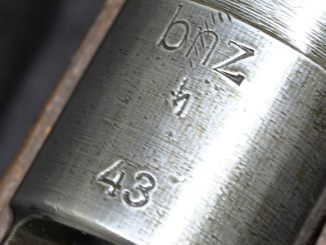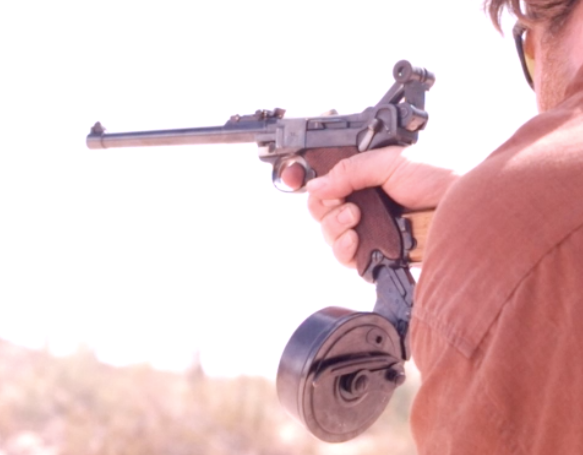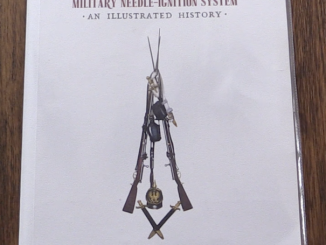When Germany began looking in late 1915 for a new weapon ideally suited for the “last 200 meters” of a combat advance, Hugo Schmeisser’s blowback submachine gun would prove to be the weapon that would set the standard for virtually all submachine guns to come. It was a fully automatic only weapon with a simple blowback action and a rather slow 400 rpm rate of fire. Although relatively heavy, the only real shortcoming of the MP18,I was its use of 32 round Luger snail drum magazines, which was dictated by the German military. These magazines were unreliable and difficult to load, but they were already in production and were a reasonable logistical answer in a time when material and production shortages were an endemic problem in Germany.
The MP18,I managed to see frontline combat only in the closing few months of World War One (50,000 were initially ordered, 17,677 were produced before the Armistice, and only an estimated 3,000 actually saw frontline combat use). During that time, however, it made a significant impression, easily convincing anyone with an open mind that this new type of weapon would play a major role in future wars.
After the end of the war, the Germany Army was prohibited from using submachine guns, so most of the existing ones (including the example in today’s video) were transferred to police organizations instead.




I see that this was a mix of things. The concept is sound but the materials at hand were leftovers from other products and older concepts. Fully automatic weapons made for fighting in cramped trenches cannot use rifle ammunition and they must be handy to carry. The problem is manufacturing. We have a rifle stock because it is already available. This also explains the magazine well’s orientation. Stamped parts require more investment in tooling, hence the forged receiver and barrel shroud. The drum magazine was already in production so why bother creating a new box magazine to fit the MP18? Did I mess up?
“This also explains the magazine well’s orientation.”
Cause for such magazine orientation, might be caused by will to have weapon optimized for firing from prone position.
I doubt in rifle stock usage affecting this choice, as magazine house was already ahead of it, see 2nd photo from top here:
http://modernfirearms.net/smg/de/mp1-i-schmeisser-e.html
Cherndog almost certainly means the rearward cant of the magazine, which matches the available Luger magazines.
This was a mechanical necessity, as the feed angle of the Trommelmagazine 08/13 was intended to feed reliably in the P.08, with the straight section of course going up into the pistol’s magazine well in its angled grip. The magazine housing of the MP.18/1 therefore had to be designed to match the angle of the P.08’s magazine well to the barrel. Otherwise, the magazine would not only not feed reliably, it wouldn’t feed at all.
cheers
eon
Apparently Hugo Schmeisser not only designed the world’s first issued sub-machinegun but the first mass-issued assault rifle (MP43). Wish someone would write a book about that family.
both guns have more in common than we might think, in that they both pioneered the use of the ‘constant recoil’ operating cycle, as does the Singapore Ultimax 100.
The extraordinary amount of bolt travel keeps the recoiling mass from striking the rear of the receiver, and cuts the cyclic rate way down.
I read it also had advance primer ignition which might explain the 2 piece firing pin. if the tip stick a little farther out than normal for a slam firing gun, it would fire the cartridge just before the bolt is fully seated, firing the cartridge and allowing it to push back and slow down the still moving bolt, lessening how hard the bolt hits the front stop and slowing down its recoiling velocity. Works great if everything in the system is very consistent, especially the primers, which during war time, can be of varying quality.
Thanks for the look inside this very important ‘first’ and mostly forgotten sub-machinegun.
Jim
“about that family.”
I know about following article in Russian language: http://www.kalashnikov.ru/medialibrary/954/10_18.pdf
For clarity: Schmeisser family member were as follow:
Louis Schmeisser, born 1848
Hugo Schmeisser (son of Louis), born 1884, 1st son, 4th child
Otto Schmeisser (son of Louis), born 1886
Hans Schmeisser (son of Louis), born 1889
Hugo Schmeisser also designed 6,35-mm (.25) automatic pistol: Schmeisser-Pistole also known as Haenel-Schmeisser:
http://unblinkingeye.com/Guns/HS25/hs25.html
Obviously it was not first vest-pocket automatic pistol in world, but has some interesting feature, like safety which must be engaged for magazine removal.
[This post is not related directly to MP18 topic, so ignore following text if you wish]
Forensic Lip-reader gives voice to soldiers at The Somme
https://www.youtube.com/watch?v=ezVIcFW24qE
Ian,
I studied the actual patent for the MP-18 a while ago, and it did mention the purpose of the separate firing pin. I’m still not fully clear on what that purpose IS, though. I think it’s so that the bolt can be slowly lowered into a chamber with a live cartridge without detonating it? It may be a vestigial feature (perhaps from an earlier closed-bolt version?), as the only sentence regarding it is in a paragraph by itself at the end:
“The loose bearing of the firing pin in the bolt allows a cartridge located in the chamber to be removed without ignition by the slow-moving firing pin so far away that the extractor can grasp the cartridge and withdraw it.” (translated)
It may have just been for easy replaceability, though. I’ve got a document from 1919 laying out the initial training regimen and manual of arms for submachinegunners, and I think it shows that every crate of ammunition also comes with a replacement mainspring, a replacement firing pin, and a magazine loader.
It occurs to me that one reason for designing an open-bolt SMG to be safely carried with the bolt fully-forward, even when it already has a rear-position safety catch, could be because it’s a lot less likely to get mud and dirt into the action on a weapon with no dust cover.
That makes sense, since one would have been running through no-man’s land prior to shooting anything…
Recall that these would have been for Stoßtruppen, heading for the rear areas with a minimum pack, expected to capture food on the run, and generally wreaking havoc in the rear trenches with their machine gun emplacements, artillery parks, munitions depots, and command and control centeres á la Oskar von Hutier’s tactics to restore infantry mobility.
Having a bunch of ammo bearers is exactly like how grenadiers first operated–a robustly built, athletic young lad who could really pitch the things… Or in the case of Chevalier’s WWI-novel “Le Peur/Fear” an absent-minded naive soldier who looked over the parapet in the prospect of “seeing the enemy” and being thought to be an especially fool-hardy, brave youth. The grenadier would have grenade carriers literally pass him extras as he “bombed along the traverses.”
What strikes me about the MP18,I layout is how simple disassembly is… Influence on the Soviet Shpagin PPSh41? Similarly a catch allows the receiver to rotate forward so the return spring and bolt can be removed. The French STA 1924 9x19mm too:
http://smallarmsreview.com/display.article.cfm?idarticles=1368
A very informative episode! Incidentally, I’ve seen an odd grip style for side-mounted magazines that feed from the left: A group of French Maquisards hold the barrel nut of Sten guns overhand, with the magazine assembly resting on the top of the support forearm. Don’t know how common that was, but the “Welgun” SOE prototype apparently deliberately used a kindred if odd-ball grip style. And speaking of odd-ball: There was a Danish prototype where the foregrip was literally a spherical wooden orb mounted on a pintle to the rest of the gun. I guess the idea was a sort of “universal” support grip like an orange or small grapefruit…
“(…)spherical wooden orb(…)”
Photo of Lettet Forsøgs-maskinpistol might be found here: http://www.nazarian.no/wep.asp?id=990&group_id=4&country_id=57&lang=0
Hi,
re the separate firing pin/bolt assembly glad this was raised as it is something I have always wondered about. According to Ian Hogg’s book “Guns and How They Work” the Bergmann used differential recoil.
A shortened version of his (lengthy) explanation is that it is the extractor claw on the bolt that actually strips a round from the magazine and pushes it into the chamber. When the round is chambered the claw snaps over the cartridge rim, the bolt jumps forward, the firing pin hits the primer and fires the round. But, because the bolt and pin are separate pieces, the bolt continues moving forward freely for a small distance (the recoil spring loads the firing pin, not the bolt) as the bullet is recoiling.
The recoil first has to stop the bolt moving forward before it can move it back. This uses up a large part of the recoil energy, which meant that the bolt didn’t need as much mass, and was lighter/shorter than if it was purely blowback.
When I read this I thought it was such a brilliant piece of engineering, I hope it’s not one of those theories that turns out to be completely unnecessary (i.e. Blish Block) and it is all just simple blow back.
“uses up a large part of the recoil energy, which meant that the bolt didn’t need as much mass, and was lighter/shorter than if it was purely blowback.”
There exist also so-called soft recoil mechanism, which can be applied to artillery pieces, described here:
https://www.reddit.com/r/MilitaryGfys/comments/3bffab/soft_recoil_modrn_application_hawkeye_lightweight/
it was used in few designs (see XM204 howitzer), but it need precise timing to work as intended.
In his Textbook of Automatic Pistols, R. K. Wilson called this a “Differential Locking System”. As well, I would imagine that in the event of a broken striker tip, it would be less of a drain on resources to replace the striker alone, rather than the entire bolt. As an interesting aside, Wilson also stated in that work that “The Bergmann Musquete is probably the most difficult firearm to shoot with that has ever been produced at any time in the long history of war.” He attributed this to a relatively long lock time and the weight of the reciprocating parts (1lb, 9oz). Not a ringing endorsement, it certainly wasn’t a precision instrument, nor was it meant to be, but it did pave the way for pretty much all submachine gun development to follow.
I am also given to wonder if the separate firing pin was not a safety feature against a bolt not yet totally in battery. Noting the EMP’s separately-engaged firing pin, and also the almost fanatic measures in the Mauser rifles for venting gas from ruptured cases, I would posit that the MP 18’s firing pin could not reach the primer until the bolt fully enclosed the case head or had pushed it all the way into the chamber. Not a bad idea in case of dirty, fouled, muddy, or corroded innards. This is a guess, repeat, this is a guess; in case of actual documentation being discovered pro or con, please publish here.
Nicely done. Thanks
Very informative article about a very important gun. These guns are not uncommon in museums here in Australia. Probably captured during the ‘spring offensive’ of 1918 in which Australian troops were heavily involved.
Hey Ian, where can I find info/pics of the designs that the MP18 beat? Would love to know what the Stormtroopers could have been armed with had history moved differently. Love your work!
Any mention of what type ammunition was used originally with the MP18? Using modern 9×19 parabellum with 115grn ball nose seems “cramped” in the straight section of the snail mags.
Would they have originally used something more rounded like a 95grn 9×18 makarov type projectile? Any help in this matter greatly appreciated.
The 124 grn 9mm ball ammo is the same load and weight as the German WWI loading, but may not be the exact shape of the German WWI bullet- my P08 especially likes the more powerful 124 grain standard 9mm ball, as that’s what it was made for, and set up to recoil with. Hope that helps!